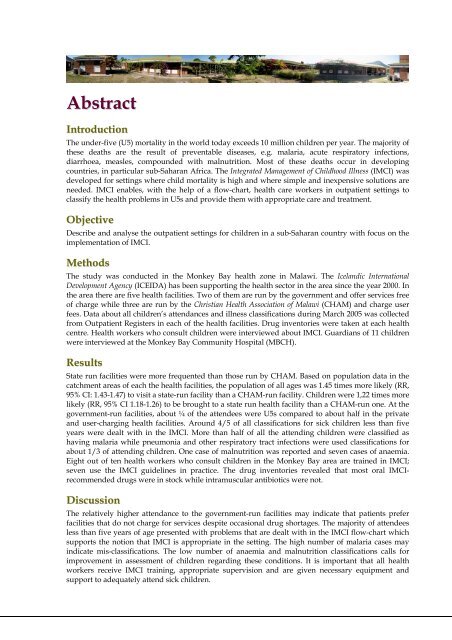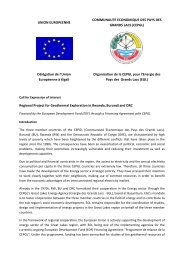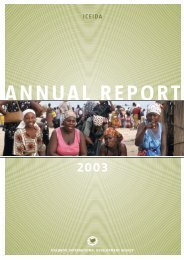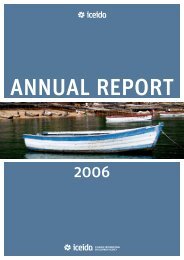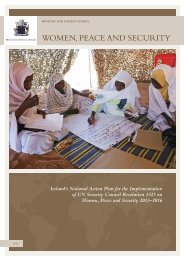The Implementation of Integrated Management of Childhood Illness ...
The Implementation of Integrated Management of Childhood Illness ...
The Implementation of Integrated Management of Childhood Illness ...
You also want an ePaper? Increase the reach of your titles
YUMPU automatically turns print PDFs into web optimized ePapers that Google loves.
Abstract<br />
Introduction<br />
<strong>The</strong> under-five (U5) mortality in the world today exceeds 10 million children per year. <strong>The</strong> majority <strong>of</strong><br />
these deaths are the result <strong>of</strong> preventable diseases, e.g. malaria, acute respiratory infections,<br />
diarrhoea, measles, compounded with malnutrition. Most <strong>of</strong> these deaths occur in developing<br />
countries, in particular sub-Saharan Africa. <strong>The</strong> <strong>Integrated</strong> <strong>Management</strong> <strong>of</strong> <strong>Childhood</strong> <strong>Illness</strong> (IMCI) was<br />
developed for settings where child mortality is high and where simple and inexpensive solutions are<br />
needed. IMCI enables, with the help <strong>of</strong> a flow-chart, health care workers in outpatient settings to<br />
classify the health problems in U5s and provide them with appropriate care and treatment.<br />
Objective<br />
Describe and analyse the outpatient settings for children in a sub-Saharan country with focus on the<br />
implementation <strong>of</strong> IMCI.<br />
Methods<br />
<strong>The</strong> study was conducted in the Monkey Bay health zone in Malawi. <strong>The</strong> Icelandic International<br />
Development Agency (ICEIDA) has been supporting the health sector in the area since the year 2000. In<br />
the area there are five health facilities. Two <strong>of</strong> them are run by the government and <strong>of</strong>fer services free<br />
<strong>of</strong> charge while three are run by the Christian Health Association <strong>of</strong> Malawi (CHAM) and charge user<br />
fees. Data about all children’s attendances and illness classifications during March 2005 was collected<br />
from Outpatient Registers in each <strong>of</strong> the health facilities. Drug inventories were taken at each health<br />
centre. Health workers who consult children were interviewed about IMCI. Guardians <strong>of</strong> 11 children<br />
were interviewed at the Monkey Bay Community Hospital (MBCH).<br />
Results<br />
State run facilities were more frequented than those run by CHAM. Based on population data in the<br />
catchment areas <strong>of</strong> each the health facilities, the population <strong>of</strong> all ages was 1.45 times more likely (RR,<br />
95% CI: 1.43-1.47) to visit a state-run facility than a CHAM-run facility. Children were 1,22 times more<br />
likely (RR, 95% CI 1.18-1.26) to be brought to a state run health facility than a CHAM-run one. At the<br />
government-run facilities, about ¼ <strong>of</strong> the attendees were U5s compared to about half in the private<br />
and user-charging health facilities. Around 4/5 <strong>of</strong> all classifications for sick children less than five<br />
years were dealt with in the IMCI. More than half <strong>of</strong> all the attending children were classified as<br />
having malaria while pneumonia and other respiratory tract infections were used classifications for<br />
about 1/3 <strong>of</strong> attending children. One case <strong>of</strong> malnutrition was reported and seven cases <strong>of</strong> anaemia.<br />
Eight out <strong>of</strong> ten health workers who consult children in the Monkey Bay area are trained in IMCI;<br />
seven use the IMCI guidelines in practice. <strong>The</strong> drug inventories revealed that most oral IMCIrecommended<br />
drugs were in stock while intramuscular antibiotics were not.<br />
Discussion<br />
<strong>The</strong> relatively higher attendance to the government-run facilities may indicate that patients prefer<br />
facilities that do not charge for services despite occasional drug shortages. <strong>The</strong> majority <strong>of</strong> attendees<br />
less than five years <strong>of</strong> age presented with problems that are dealt with in the IMCI flow-chart which<br />
supports the notion that IMCI is appropriate in the setting. <strong>The</strong> high number <strong>of</strong> malaria cases may<br />
indicate mis-classifications. <strong>The</strong> low number <strong>of</strong> anaemia and malnutrition classifications calls for<br />
improvement in assessment <strong>of</strong> children regarding these conditions. It is important that all health<br />
workers receive IMCI training, appropriate supervision and are given necessary equipment and<br />
support to adequately attend sick children.<br />
4


